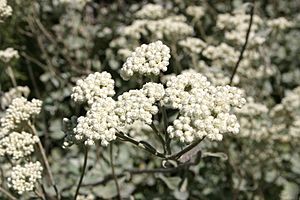Licorice-plant facts for kids
Quick facts for kids Licorice-plant |
|
|---|---|
 |
|
| Scientific classification | |
| Genus: |
Helichrysum
|
| Species: |
petiolare
|
| Synonyms | |
|
|
The Helichrysum petiolare, also known as the licorice-plant or liquorice plant, is a type of flowering plant. It belongs to the family called Asteraceae. This plant originally comes from South Africa, where people call it imphepho. You can also find it growing naturally in parts of Portugal and the United States.
This plant can grow to about 45 centimeters (18 inches) tall and spread out to 150 centimeters (59 inches) wide. It is an evergreen subshrub, which means it stays green all year and is a small, woody plant. It has soft, furry grey-green leaves and small white flowers. Other common names for it include silver-bush everlastingflower, trailing dusty miller, and kooigoed. Its leaves have a light smell like licorice. However, it's important to know that Helichrysum petiolare is not the same as the true licorice plant, which is called Glycyrrhiza glabra.
Contents
Growing the Licorice Plant
People grow Helichrysum petiolare for its attractive leaves and to use it as a groundcover. Groundcover plants spread out and cover the soil. This plant likes sunny spots or places with a little shade. It needs soil that drains water well, because its roots can rot if the soil stays too wet.
The licorice plant can survive in warmer areas where temperatures usually don't drop below freezing for long periods. It grows best in a sunny, protected spot.
Many different types of this plant, called cultivars, have been created. Some of these have won awards, like the Royal Horticultural Society's Award of Garden Merit. These include:
- H. petiolare
- 'Goring Silver'
- 'Limelight'
- 'Variegatum'
About the Imphepho Plant
In Southern Africa, the name imphepho is used for about 250 different types of plants from the Helichrysum group. The Helichrysum plants known as imphepho grow very well in South Africa, Eswatini, and Lesotho. They are especially common near coastal areas and in the dry Northern Cape province.
These plants grow easily in gardens and in the wild. Because of this, most imphepho is collected from nature, and people don't usually grow it on farms in South Africa. Helichrysum species used as imphepho are strong and can adapt to many conditions. They grow in different types of soil, can handle dry weather, strong winds, and even light frost. Their seeds are spread by the wind.
People who use imphepho don't usually prefer one specific type over another. For traditional healers, it's more important that the plant is easy to find nearby. There isn't much proof that some Helichrysum species have stronger healing powers. For special ceremonies, all types are treated the same.
For health and traditional uses, people mainly use the parts of the plant that grow above ground, like leaves and stems. These are often dried, but sometimes used fresh. The roots are used less often.
Uses of Helichrysum petiolare
The Afrikaans name for this plant, kooigoed, means "bedding stuff." Long ago, and sometimes even today, people used it to make soft, nice-smelling mattresses.
Scientists have studied the plant's natural oils. They found that these oils might help fight germs, act as antioxidants (which protect cells), and reduce swelling. In South Africa, this plant is an important part of traditional African medicine. People boil the leaves and small branches to make a tea that can help with coughs and fevers. The leaves are also put on wounds to help prevent infection. Sometimes, the plant is burned in ceremonies to create a special type of incense.
The papery flowers of different Helichrysum species come in many colors, like bright yellow, white, pink, and orange. They are popular in flower arrangements and are sometimes used in potpourri to make things smell nice.
Traditional and Cultural Uses
In traditional ceremonies and rituals, imphepho is often burned in large amounts. It is usually burned indoors, sometimes in small, poorly ventilated huts. The smoke acts like incense. Before and during talks with ancestors for guidance, traditional healers called Sangomas will burn imphepho. The parts of the plant above ground (leaves, twigs, and flowers) are gathered and tied into tight bundles, which are then dried. A bundle of imphepho can smolder for a long time, making a lot of smoke.
Burning imphepho is seen as a way to honor ancestors and offer something to them. While it's mainly used in traditional ceremonies and medicine, individuals might also use it privately. They might burn it to feel more positive, for meditation, or for other personal reasons.
The smoke from imphepho has a unique smell. Some people describe it as similar to mildew and camphor, with a hint of fenugreek.
South African law protects the right of people to burn imphepho as part of their traditional beliefs and ceremonies. Even though its use is often linked to African traditional beliefs, imphepho is sometimes burned as incense in South African Christian churches. Here, it's thought to be used in a similar way to frankincense, not for honoring ancestors.
See also
In Spanish: Helichrysum petiolare para niños

